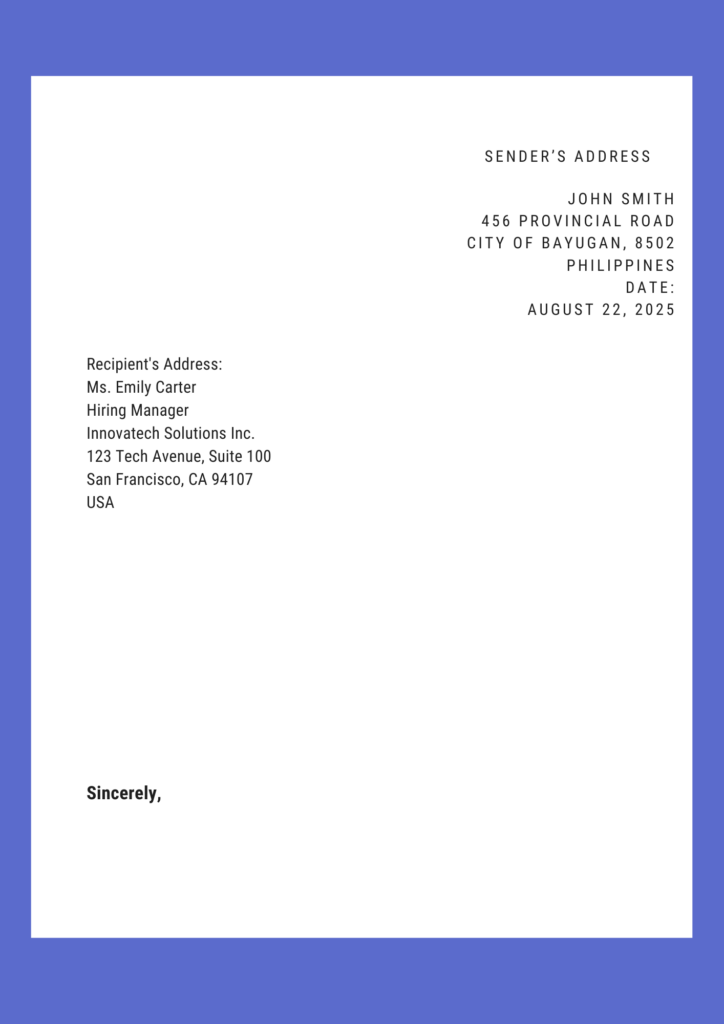
How to write address in formal letter? A well-crafted formal letter can open doors to new opportunities, resolve critical issues, and build lasting business relationships. Yet, before the first word of your message is even read, your letter makes a first impression with its formatting. Among the most crucial of these details is the address. Knowing the correct rules for formatting an address is not just a matter of etiquette; it is a fundamental component that ensures deliverability and signals your professionalism.
This guide will provide you with the definitive rules you need to know on how to write address in formal letter. We will break down the components, placement, and structure of both the sender’s and recipient’s addresses, and provide five practical examples for different formal situations, ensuring your correspondence always looks polished and professional.
The Two Essential Addresses in a Formal Letter
Every formal letter contains two primary addresses on the letter page itself, distinct from the address on the envelope.
- The Sender’s Address (Your Address): This is your address, also known as the return address. It allows the recipient to easily know where the letter originated from and where to send a reply. It should be the very first thing at the top of the letter.
- The Recipient’s Address (The Inside Address): This is the address of the person or company you are writing to. It is placed below the sender’s address and the date. This ensures that even if the letter is separated from its envelope, it can still be directed to the correct recipient within an organization.
The Fundamental Rules of Formal Address Formatting
Adhering to a standardized format is key. The most widely accepted format in business correspondence, particularly in the United States, is the block format.
1. Placement and Alignment
- Sender’s Address: Place this in the top-left corner of your letter.
- Date: Leave one blank line space after your address, and then type the full date (e.g., August 22, 2025).
- Recipient’s Address: Leave one blank line space after the date, and then type the recipient’s address.
- Alignment: All lines of both addresses should be left-aligned (flush against the left margin) with no indentation.
2. Structure and Order of Information
The order of information is critical for clarity and postal service requirements. Follow this sequence for both addresses:
- Line 1: Full Name and/or Title: Start with the full name of the recipient (e.g., Ms. Jane Doe). If you know their professional title, include it on this line or the next (e.g., Jane Doe, Director of Human Resources).
- Line 2: Company or Organization Name: The name of the business or institution.
- Line 3: Street Address: Include the full street address (e.g., 123 Business Road). Use apartment or suite numbers on this line if applicable (e.g., 123 Business Road, Suite 450).
- Line 4: City, State, and ZIP Code: The city, followed by a comma, the state (use the two-letter postal abbreviation like CA for California), and the ZIP code.
- Line 5 (for International Mail): The full name of the country in capital letters.
3. Punctuation and Spacing
- Spacing: Each piece of information should be on its own line. The entire address block should be single-spaced.
- Punctuation: Use a comma between the city and state. It is generally advised to avoid using other punctuation, such as commas at the end of lines, for a cleaner, more modern look.
4. Abbreviations
While full words are preferred for utmost formality, standard postal abbreviations are acceptable and often necessary for automated mail sorting.
- Use two-letter state abbreviations (e.g., NY, TX, FL).
- Use standard abbreviations for street types like “St.” for Street, “Ave.” for Avenue, “Blvd.” for Boulevard, and “Dr.” for Drive.
- Abbreviate directional indicators (e.g., “N.” for North, “SW” for Southwest).
Mastering these rules is the core of learning how to write address in formal letter and will ensure your documents are always impeccable.
5 Examples of Formal Letter Intent with Address Formatting

Here are five scenarios demonstrating how to apply these rules.
Example 1: Job Application Cover Letter
Situation: You are applying for a specific role and addressing your cover letter to the hiring manager.
Sender’s Address (Your Address):
John Smith
456 Provincial Road
City of Bayugan, 8502
Philippines
Date:
August 22, 2025
Recipient’s Address:
Ms. Emily Carter
Hiring Manager
Innovatech Solutions Inc.
123 Tech Avenue, Suite 100
San Francisco, CA 94107
USA
Explanation: This format is direct and professional. It includes the hiring manager’s name and title, ensuring it gets to the right person. Since it’s international, both the sender’s and recipient’s countries are included in all caps.
Example 2: Formal Complaint to a Company
Situation: You are writing to a company’s customer service department to formally complain about a faulty product. You don’t know a specific person’s name.
Sender’s Address (Your Address):
Maria dela Cruz
789 National Highway
Butuan City, 8600
Philippines
Date:
August 22, 2025
Recipient’s Address:
Customer Service Department
Global Electronics Corp.
PO Box 5000
New York, NY 10001
USA
Explanation: When you don’t have a specific name, addressing it to a department is the correct protocol. This example also shows how to correctly format a Post Office Box address. Correctly formatting this is a key part of understanding how to write address in formal letter.
Example 3: Inquiry to a University Admissions Office
Situation: You are a prospective student writing a letter to a university to inquire about a specific graduate program.
Sender’s Address (Your Address):
David Lee
101 University Drive
Cebu City, 6000
Philippines
Date:
August 22, 2025
Recipient’s Address:
Office of Graduate Admissions
Attention: Engineering Department
Stanford University
450 Serra Mall
Stanford, CA 94305
USA
Explanation: This demonstrates how to use an “Attention” line to direct the letter to a specific department within a larger office. The “Attention” line is placed below the main office name and above the street address.
Example 4: Letter to a Government Official
Situation: You are a citizen writing to your elected representative about a local issue.
Sender’s Address (Your Address):
Anna Reyes
222 Community Street
Davao City, 8000
Philippines
Date:
August 22, 2025
Recipient’s Address:
The Honorable [Official’s Full Name]
Mayor of [City Name]
[City Hall Address]
[City, ZIP Code]
Philippines
Explanation: Addressing government officials requires a specific honorific, such as “The Honorable.” It is crucial to research the correct title for the official you are addressing to maintain the highest level of formality.
Example 5: Formal Acknowledgement of a Donation
Situation: A non-profit organization is sending a formal thank-you letter to a corporate sponsor for their recent contribution.
Sender’s Address (The Organization’s Address):
Caraga Hope Foundation
333 Charity Lane
City of Bayugan, 8502
Philippines
Date:
August 22, 2025
Recipient’s Address:
Mr. Carlos Tan
Director of Corporate Giving
Tan Marketing Solutions
456 Business Park Drive
Makati City, 1229
Philippines
Explanation: This letter is a crucial part of donor relations. The format is standard, but its purpose is specific. The entire letter design for acknowledgement must be professional and appreciative, and that begins with a perfectly formatted address that shows respect and attention to detail.
Conclusion: Professionalism Begins with the Address
While the content of your letter is undoubtedly important, the formatting of the address sets the professional tone from the very beginning. By following these clear rules and understanding the nuances of different situations, you can ensure your formal correspondence is always impeccable. Mastering how to write address in formal letter is a simple yet powerful skill that demonstrates your thoroughness, respect for convention, and attention to detail qualities that are universally valued in the professional world.

I’m Ethan Richards, the guy running the show at “Acknowledgment Templates.” I’ve been playing with expressions and formats to make acknowledgment writing a whole lot of fun. Over at Acknowledgment Templates, we’re here to make your acknowledgment section incredible. Let’s add some professionalism and gratitude to your project together!



